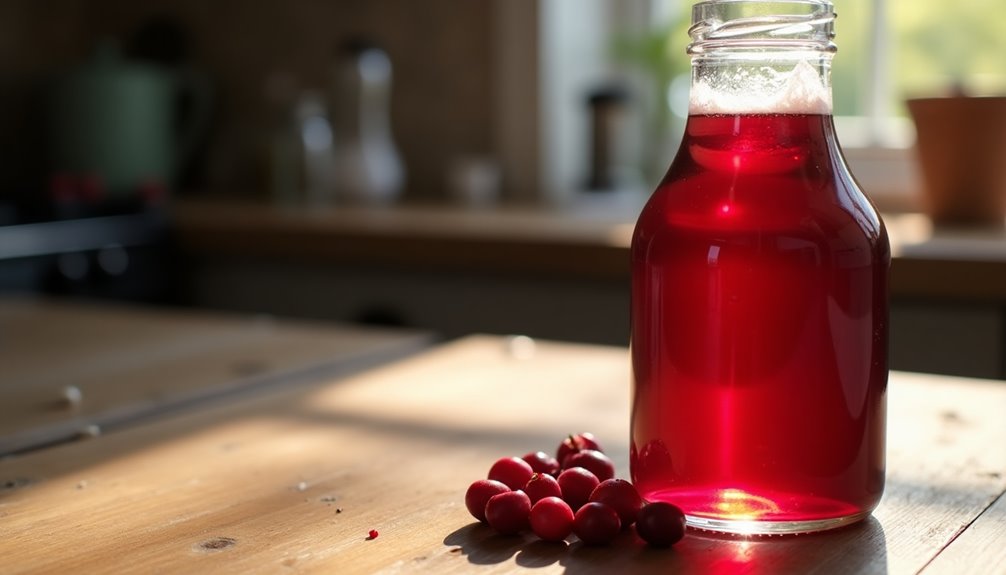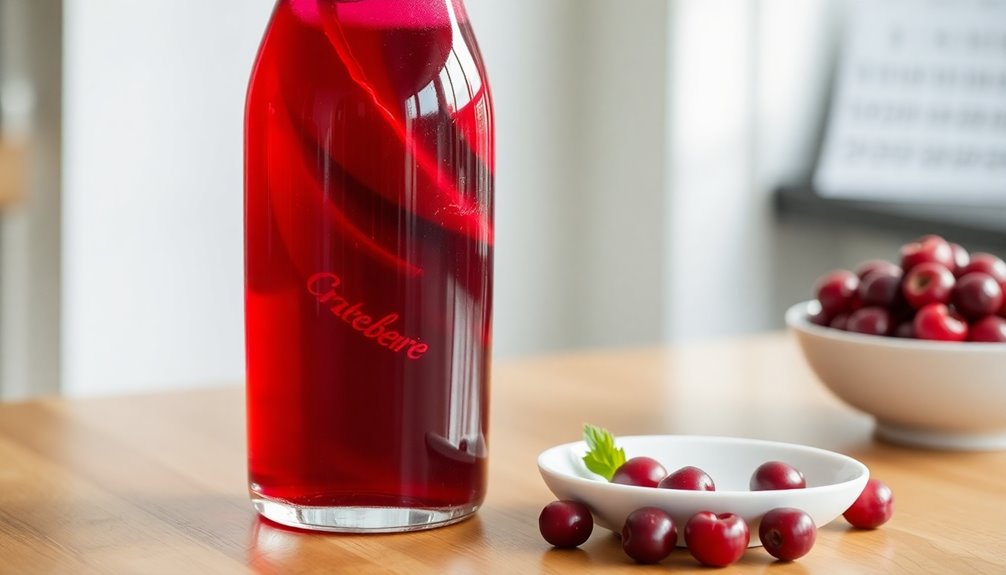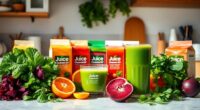Once you open cranberry juice, it typically lasts for about two to three weeks if you store it properly in the refrigerator. For the best flavor and quality, try to drink it within the first week. Always check for any signs of spoilage, like changes in odor, flavor, or appearance. Keeping it in an airtight container can help maintain its freshness longer. Want to know more about keeping you cranberry juice fresh?
Key Takeaways
- Opened cranberry juice lasts about two to three weeks when properly refrigerated.
- Store in an airtight container to minimize oxidation and extend shelf life.
- Best flavor and quality are achieved if consumed within the first week.
- Monitor for spoilage signs like off odors, altered flavors, or cloudiness.
- Discard juice if any signs of spoilage are detected to ensure safety.

Have you ever wondered how long cranberry juice really lasts after you crack it open? You might be surprised to learn that opened cranberry juice has a relatively short shelf life, typically lasting about two to three weeks when stored properly in the refrigerator. To maximize its longevity, it’s essential to keep the juice tightly sealed in its original container or transferred to an airtight bottle. Additionally, exposure to light and heat can shorten its shelf life, so always store it in a cool, dark place. If you’re curious about how to store opened clamato juice, the same principles apply: keep it refrigerated and ensure it is sealed tightly to maintain its flavor and freshness.
It's important to keep that bottle sealed tight because continuous refrigeration is crucial for maintaining the quality of your juice. When you open that bottle, the clock starts ticking. If you want to enjoy the best flavor, odor, and appearance, try to consume the juice sooner rather than later.
While it may last up to three weeks in an airtight container, you'll want to monitor it for any signs of spoilage. Once opened, the juice is more susceptible to changes that can affect its quality.
You should pay attention to several indicators of spoilage. If you notice a change in odor, that's your first warning sign. Fresh cranberry juice should have a tart and fruity aroma, but if it starts to smell off or sour, it's time to toss it out.
The flavor is another crucial aspect to consider. If you take a sip and it tastes different—perhaps overly sweet or tangy—don't hesitate to discard it. The appearance also matters; any cloudiness, sediment, or mold is a clear indication that your juice has gone bad.
To maximize the shelf life of opened cranberry juice, store it in the refrigerator at all times. Ideally, keep it in an airtight container if the original packaging isn't resealable. This helps minimize exposure to air and prevents oxidation, which can lead to spoilage.
Remember, even if the juice looks and smells fine, always trust your senses before consuming it. Generally, if you've opened your cranberry juice, aim to drink it within the first week for the best quality.
After that, while it may still be safe to consume, the flavor and freshness can degrade significantly. So, if you've got a half-full bottle sitting in the back of your fridge, it's worth checking on before you pour yourself a glass.
Cranberry juice is a delicious and refreshing beverage, but like many other juices, it doesn't last forever once opened. With proper storage in the refrigerator and by keeping it in an airtight container, you can enjoy it for a few weeks.
Just keep an eye out for any changes in odor, flavor, or appearance. If you notice any signs of spoilage, it's best to err on the side of caution and discard it. After all, nothing beats the fresh taste of cranberry juice—so enjoy it at its peak!
Frequently Asked Questions
How Long Can You Keep an Open Bottle of Cranberry Juice in the Fridge?
You can keep an open bottle of cranberry juice in the fridge for about 2-3 weeks.
Make sure you store it in a tightly sealed container to maintain its quality.
Always check for any changes in odor, flavor, or appearance before drinking.
If you notice mold or an off smell, it's best to discard it.
For optimal freshness, try to consume it within that recommended timeframe to enjoy its taste and benefits.
How to Tell if Cranberry Juice Went Bad?
To tell if your cranberry juice has gone bad, check for off odors like sour or fermented smells.
Look for any color changes, such as darkening or cloudiness. If you see mold or floating particles, it's time to toss it out.
Give it a taste; if it's unpleasant or rancid, don't drink it.
Also, inspect the container for leaks, rust, or bulging, as these signs indicate spoilage.
Stay safe!
Is It OK to Drink Old Cranberry Juice?
Did you know that nearly 20% of people unknowingly consume spoiled juice?
When it comes to drinking old cranberry juice, it's crucial to use your senses. If you notice off odors, strange flavors, discoloration, or mold, it's best to toss it.
Even if it looks okay, it's wise to check for spoilage signs before drinking. Remember, safety first! Trust your instincts and don't risk your health for an old beverage.
How Long Does Opened Juice Last in the Refrigerator?
When you open juice, it typically lasts about 7 to 10 days in the refrigerator.
To keep it fresh, make sure you store it in an airtight container or tightly sealed bottle. Constant refrigeration is key to preventing spoilage.
Always check for signs of spoilage like off odors, strange flavors, or any discoloration before you drink it.
For the best taste and quality, try to consume it within that timeframe.
Conclusion
In conclusion, once you crack open that bottle of cranberry juice, you've got about 7 to 10 days to enjoy it before it starts to lose its freshness. To keep it tasting great, always store it in the fridge and make sure to check for any signs of spoilage. Remember, good things don't last forever, so make the most of that delicious juice while you can! Cheers to a tasty drink and your health!
Cindy thoroughly researches juicing trends, techniques, and recipes to provide readers with practical advice and inspiration. Her writing style is accessible, engaging, and designed to make complex concepts easy to understand. Cindy’s dedication to promoting the advantages of juicing shines through her work, empowering readers to make positive changes in their lives through the simple act of juicing.











